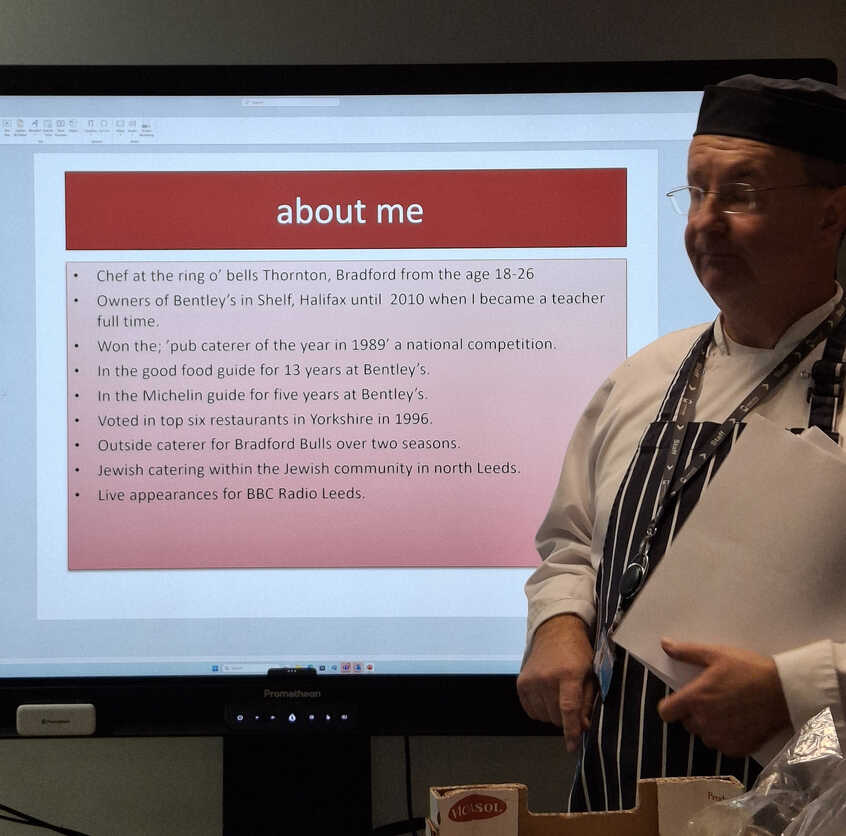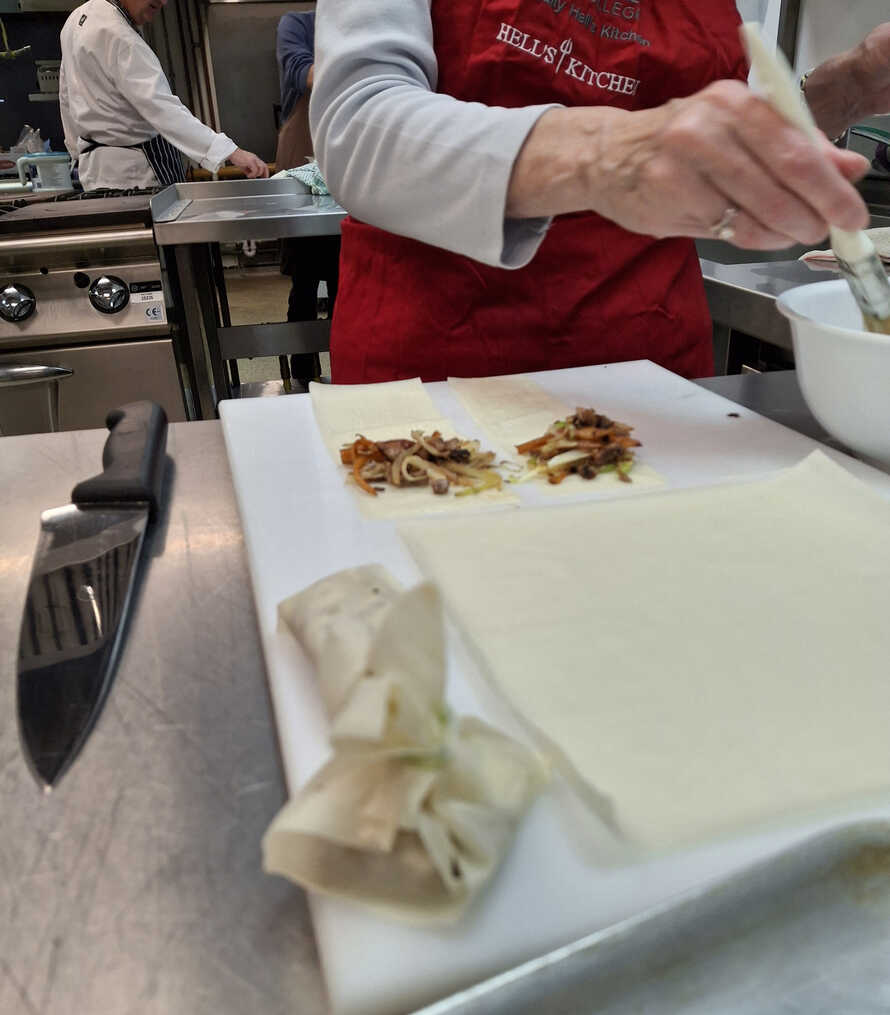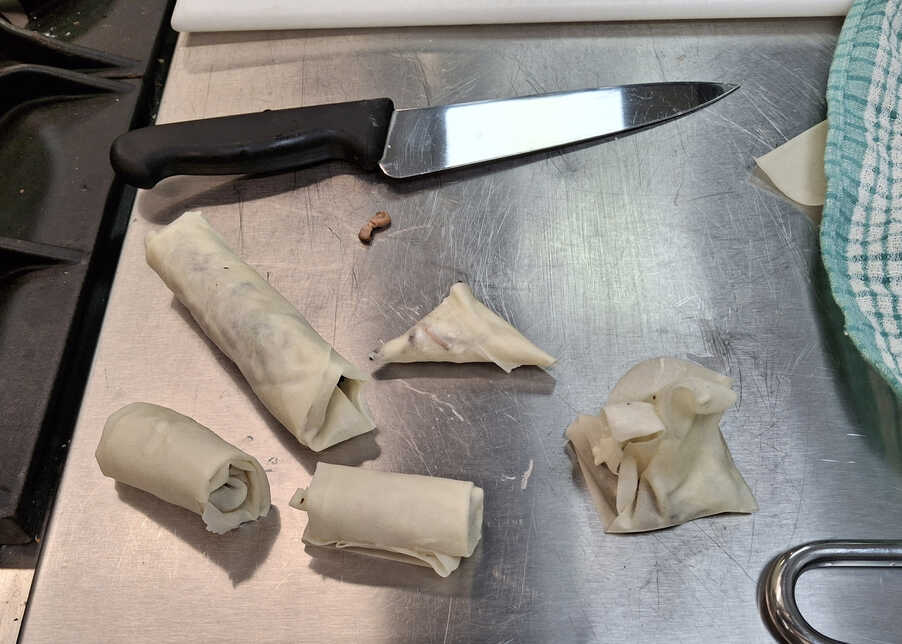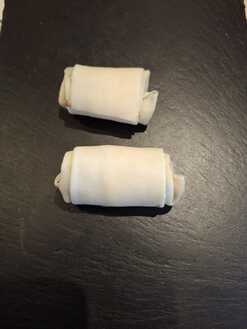23rd September 2025 - Paul Cadillac
Street Food 3 - Taster - Spring Rolls

A new course and a new instructor - we're all very excited!
We made ducky spring rolls - a quick and easy introduction to Street Food that aren't tacos, whilst Teacher Paul regaled us with cautionary tales from his time as a jaded restaurateur.
He has a great wealth of experience to draw on, and his stories were enormously entertaining.
He offered much advice as to how, should we be inclined to engage in Street Food production in a professional capacity, we might prevent our greedy customers from gobbling up all the potential profits.
Though it mostly consisted of avoiding the catering industry entirely.
Not only that but he also found time to demonstrate how to wrap spring rolls!
It turns out he's really good at this stuff - his first tip being to prepare a flour-and-water paste
glue to hold the wrappers together (or you could use egg white).
Paul recommends using two layers of wrapper at a time, though feel free to use one or more layers if you prefer.
Lay the two sheets smooth side down on top of each other on a board.
Prepare your wrapper by brushing around the edges with the flour paste
glue.
- If starting with a square shape, lay the filling near a corner, fold the side corners over, and then roll up from the nearest corner keeping the roll tight. Brush more paste onto the last flap as you roll it in.
- If starting from a rectangle - say by cutting the sheets in half so as to make daintier rolls, lay the filling close to a narrower edge.
Fold over the longer sides, then roll up tightly from the closer narrow edge along the rectangle.
Brush more paste onto the final section as you roll it in. You may prefer to trim the long rectangle a little if there seems to be too much wrapper.
- If you're weird you can roll them up into a triangular samosa shape by starting at one edge of an even thinner rectangle (from dividing a square into 4 strips, say):
fold the bottom edge over the stuffing to meet one of the sides making a triangular pouch, then wrap it up by just flipping and folding the triangle, edge-to-edge, all the way up the strip,
in a kind of triangular side-to-side pattern.
- Or you could make little parcels by just pulling some wrapper up around the filling and crimping it, or tying it with a piece of spring onion or a chive.
By Paul Bentley
Duck Spring Rolls
oriental fowl snack starter
Apparently there are two traditional ways of making spring roll or
Lumpia wrappers:
- The more Vietnamese batter method:
Make a thin, runny batter from mixing rice and tapioca flour, salt and water, and wiping or smearing over a lightly oiled hot pan like a crèpe,
then peel them off the pan and stack when the batter sets.
- The more Chinese dough method:
Make a dough from kneading wheat flour, salt and water, resting, rolling out very thin sheets, oiling and stacking them, rolling them even thinner,
then cooking the whole stack in a medium hot pan. Peel them apart to use.
Here in the West, we typically just buy them in packets from a supermarket.
So who's inscrutable now eh?
Either way once they're unwrapped, or defrosted you'll need to keep them covered with a damp cloth or cling film to stop them drying out and hardening,
or turning to dust and blowing away, before you get to use them.
Though we filled ours with duck, the potential is endless. You might use chicken, or prawns, meat or even
shudder no dead animals at all.
For some reason Paul seemed taken with the idea of rabbit, with mustard.
Go figure, as the Yanks say.
A quick note about frying with sesame oil:
Light, un-toasted, sesame oil has a high smoke point so you can use it for frying like any other oil, but toasted or dark sesame oil will burn at much lower temperatures,
so if you
are determined to fry with it, rather than use it as a flavouring agent, then do so at a lower temperature or mix it with other oils to prevent it from turning bitter.
- duck breast
- carrot
- cabbage
- spring onion
- yellow onion
- ginger
- garlic
- mushrooms
- spring roll wrappers
- sesame oil
- salt & pepper
- Chinese Five Spice powder
- soy sauce
- Sriracha
- fresh mint or coriander, chopped
- flour or cornflour
- water
Lightly salt the duck breast. You can use celery salt if you're squeamish. Or have an imaginary heart condition.
Place the breast skin-side down in a cold frying pan and put over a medium heat.
Allow it to cook gently two-thirds of the way through so the skin is nice and crisp, flip it for a few seconds onto the other side, then set aside to rest.
Meanwhile smash the ginger and then the garlic by laying the flat of a wide knife over them and striking firmly with your fist.
Now roughly chop, and then turn them into purée by
smearing them along the rough texture of a chopping board with the blade of your knife at an angle.
Which is great fun.
Thinly slice all the other vegetables.
When the duck is ready, and is still nice and pink in the middle , shred or mince it up.
Heat sesame oil in a frying pan until shimmering
then quickly fry the vegetables and the duck, adding them in order of the time they need to cook:
- carrots
- yellow onions
- ginger
- cabbage
- mushrooms
- garlic
- duck
- spring onions
Season and spice the filling as you like and add a teaspoon or two of soy or oyster sauce.
Perhaps a drizzle of hot sauce.
Then spread them on a small tray to cool.
Mix the flour with just enough water to make a paste with wallpaper glue consistency.
Use any of the wrapping methods described in the preamble above to form your rolls.
You can deep-fry the rolls for 2-3 minutes at 180°C until light brown, or lightly oil and bake them in an oven or air-fryer for 10-20 minutes at 180-200°C/Gas Mark 5-6, or even a bit of both if you like.
If you plan on keeping them for while before cooking them, you should wrap them individually in cling film. Don't wrap them too tightly!


